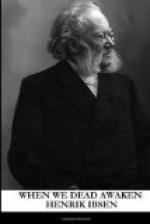When We Dead Awaken was acted during 1900 at most of the leading theatres in Scandinavia and Germany. In some German cities (notably in Frankfort on Main) it even attained a considerable number of representatives. I cannot learn, however, that it has anywhere held the stage. It was produced in London, by the State Society, at the Imperial Theatre, on January 25 and 26, 1903. Mr. G. S. Titheradge played Rubek, Miss Henrietta Watson Irene, Miss Mabel Hackney Maia, and Mr. Laurence Irving Ulfheim. I find no record of any American performance.
In the above-mentioned letter to Count Prozor, Ibsen confirmed that critic’s conjecture that “the series which ends with the Epilogue really began with The Master Builder.” As the last confession, so to speak, of a great artist, the Epilogue will always be read with interest. It contains, moreover, many flashes of the old genius, many strokes of the old incommunicable magic. One may say with perfect sincerity that there is more fascination in the dregs of Ibsen’s mind than in the “first sprightly running” of more common-place talents. But to his sane admirers the interest of the play must always be melancholy, because it is purely pathological. To deny this is, in my opinion, to cast a slur over all the poet’s previous work, and in great measure to justify the criticisms of his most violent detractors. For When We Dead Awaken_ is very like the sort of play that haunted the “anti-Ibsenite” imagination in the year 1893 or thereabouts. It is a piece of self-caricature, a series of echoes from all the earlier plays, an exaggeration of manner to the pitch of mannerism. Moreover, in his treatment of his symbolic motives, Ibsen did exactly what he had hitherto, with perfect justice, plumed himself upon never doing: he sacrificed the surface reality to the underlying meaning. Take, for instance, the history of Rubek’s statue and its development into a group. In actual sculpture this development is a grotesque impossibility. In conceiving it we are deserting the domain of reality, and plunging into some fourth dimension where the properties of matter are other than those we know. This is an abandonment of the fundamental principle which Ibsen over and over again emphatically expressed—namely, that any symbolism his work might be found to contain was entirely incidental, and subordinate to the truth and consistency of his picture of life. Even when he dallied with the supernatural, as in The Master Builder and Little Eyolf, he was always careful, as I have tried to show, not to overstep decisively the boundaries of the natural. Here, on the other hand, without any suggestion of the supernatural, we are confronted with the wholly impossible, the inconceivable. How remote is this alike from his principles of art and from the consistent, unvarying practice of his better years! So great is the chasm between John Gabriel Borkman and When We Dead Awaken that one could almost suppose his mental breakdown to have preceded instead of followed the writing of the latter play. Certainly it is one of the premonitions of the coming end. It is Ibsen’s Count Robert of Paris. To pretend to rank it with his masterpieces is to show a very imperfect sense of the nature of their mastery.




